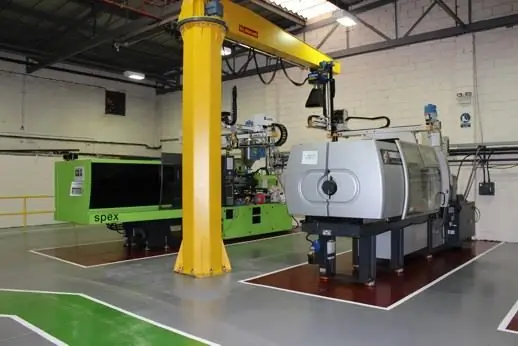2025 Author: Howard Calhoun | [email protected]. Last modified: 2025-06-01 07:12:56
Today, blacksmith shops usually do not work in isolation. Most often they are an integral part of some other large production. For example, they are quite common in the field of mechanical engineering. In addition, they are divided into several types.
Site characteristics
Modern blacksmith shop is a collection of several sites. This includes production and support departments, storage facilities, as well as service and household areas.
If we talk about each separately, then the production departments are the areas where they prepare the part, as well as the rooms where the forging hammers and presses, stamping hammers and other basic equipment for work are located. Auxiliary areas include workshops that repair the main equipment. This also includes power plants, heating plants, a laboratory, technical control over finished parts, etc.

The warehouses of the blacksmith shop usually store metal, blanks,forgings, flash, spare parts, etc.
Technological process
Today, the forge shop, like any other production site, needs to develop a technological process for efficient operation. For workshops of this type, there is one main criterion by which the production process is chosen. This criterion is the lowest cost of one ton of forgings, which will fully comply with the required quality. In second place during the selection of the main production technology is the required volume of parts, as well as possible special requirements for elements.
Most often in the forge shop, the technological process is divided into the following stages:
- separation of the desired material into blanks of the required length;
- followed by heating the workpiece and its heat treatment;
- treatment of material with high pressure to give it the desired shape;
- this is always followed by separating type processes, after which more finishing work is usually required to remove possible burrs etc.

Material heating
While working in the blacksmith shop, increased attention is paid to the process of heating the workpiece. To successfully complete this stage, it is necessary to determine the thermal conductivity of the material very accurately. Thermal conductivity refers to the process during which heat passes from the outer walls of the workpiece inward. This parameter depends on the heat capacity and density of the metal. Consequently,the higher this indicator, the faster the heat will penetrate inside, which means that less time is required to warm up. In addition, the type of metal, its chemical composition and the temperature with which the workpiece is affected also affect the thermal conductivity. It is worth noting that most often at a temperature of 700-800 degrees Celsius, the thermal conductivity coefficients of different steels are aligned.

Shop type
Today, there is a forging and pressing shop, which is designed to process an already heated workpiece. There are two ways of influence - it is dynamic or static. If a dynamic processing option is used, then forging or stamping of the material is usually used, while pressing is used for static work.

Work in the forging and pressing shop is carried out using only three types of equipment - these are hammers, stampings and presses. Heating of the material is usually carried out either in flame or electric furnaces. It should be noted that work in such a workshop is quite complicated by the fact that a heating microclimate is observed in such rooms. For example, in the warm season, the temperature at a blacksmith's workplace can be about 8-10 degrees Celsius higher than the air temperature. All this should be taken into account during the placement of furnaces and hammers, which create high thermal radiation.
Machine-building workshops
The forge shop of a machine-building plant can be divided into three types, depending on its purpose.
There are forging and stamping departments at machine-building plants. In this case, the nature of the parts produced will correspond to the selected types of mechanical engineering. It can be automotive, engine building and other types.

If we talk only about those types of workshops that can be located on the territory of a larger enterprise engaged in mechanical engineering, then there is another type - ancillary. They are mainly used for the manufacture of small forgings for the main production. They can be used to repair the factory equipment of the blacksmith shop, to produce the desired tool.
Large machine-building factories set up forging and stamping shops on their territory, as they can produce the necessary parts on a large scale. Ancillary species are usually found on the territory of medium or small plants.
What is cold forging
This technology is also used in blacksmithing. The main difference from the conventional process is that there is no preliminary stage at which the workpiece is heated to the desired temperature. In this case, only local heating of those areas where a bend needs to be made is allowed. This method is based on the plasticity of the metal.

Any metal has parameters such as tensile strength, tensile strength and tensile strength. Using these features, it is possible to process metal without preheating it. Hereit is worth mentioning that due to the absence of exposure to high temperatures, the chemical composition of the steel does not change, and therefore tempering, annealing and hardening may not be carried out.
How is forging done with this method
For cold forging, three types of operations are usually used:
- pressing a blank using manual or mechanized equipment;
- chasing is one of several processes that relate to forging without preheating, however, most often it is possible to apply an ornament only on copper, since the metal is quite soft and pliable;
- the third processing option is bending, which is one of the main ones.

Pros and cons of using this method
Of the obvious advantages, the following should be highlighted:
- firstly, there is no need for preheating, which significantly reduces the cost of products, since there is no need to purchase and use heating devices;
- secondly, the products are more durable;
- thirdly, it is possible to fit the part to the template with high accuracy;
- completely disappears or minimizes the need for additional finishing of the finished part;
- the finished product has no residue of soot and other combustion products on the surface.
However, cold forging is not without its drawbacks:
- needs to make much more effort to achieve a result than with a hotpressing;
- it is impossible to work with durable metal, which is presented in the form of sheets or blanks;
- some processing options require a huge amount of force, which requires special equipment;
- before work, you need to thoroughly clean the surface.
As a result, we can say the following. Firstly, the equipment for the forge shop is hammers, presses and stampings. In addition, depending on the operation performed, a different accessory may be used. Secondly, the forging shop today is an integral part of a larger production, and not a separate structure.
Recommended:
Electroplating shop: description, equipment, safety requirements, harmfulness

An electroplating shop is a rather important area in any production, however, it is characterized by high danger and harmfulness. In such workshops, it is necessary to equip good ventilation, fire safety and many other protection factors
How to write a cold call script. Script ("cold call"): example

Cold calls are often used in sales. With their help, you can effectively sell a product, service, make an appointment for a subsequent discussion of the terms of the transaction
"Cold" sales - what is it? Method and technology of "cold" sales

For any company, the issue of finding new customers is always relevant, which is associated with work in the "cold" market. How are cold sales different from warm sales? How to make a stranger skeptical person a "hot" client? The article contains recommendations and technologies of "cold" sales
Cold workshop: description, characteristics. Organization of the work of the cold shop

In restaurants, cafes, canteens with a workshop production structure, special rooms are allocated for the preparation of hot and cold dishes. At low-capacity enterprises, separate places are created for these purposes in the general production space
Forging and pressing production: development in Russia, features, equipment

The emergence and development of forging and pressing production in Russia, as in other countries at different times, has always been associated with growing economic needs. The development of technology, as well as the changing needs of mankind, led to the fact that there were several powerful pushes that ensured the development of the industry

